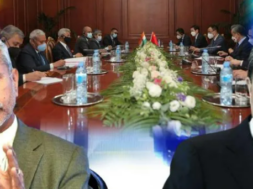
Roving Periscope: Now, an exposed China is hoist with its own petard!
Virendra Pandit
New Delhi: William Shakespeare’s immortal lines in Hamlet describes China’s predicament: “When sorrows come, they come not as single spies, but in battalions”.
Wary of the US-led West’s sanctions, China had to suspend a USD 500 million investment in Russia. And its problems have just piled up on multiple fronts.
For the first time, on March 23, a Kashmiri intellectual, Junaid Qureshi, took the Chinese representative by surprise when he raised the Aksai Chin’s issue at UN Human Rights Council (UNHRC) in Geneva, asking it to formalize the term “China-occupied Jammu & Kashmir”. Aksai Chin comprises over 20 percent of the Jammu & Kashmir territory. Beijing illegally occupied the 38,000 km area during the 1950s and strengthened its military grip over it in the 1962 India-China war.
In the same week, Chinese Foreign Minister Wang Yi’s four-nation South Asian tour—to Pakistan, Afghanistan, India, and Nepal—proved how the Dragon is tying itself up in knots.
At the invitation of Pakistan, Wang became the first Chinese Foreign Minister to address the 57-nation Organisation of Islamic Cooperation (OIC) conference in Islamabad as a “special guest”. On March 22, his reported statement at the opening ceremony of the 48th session of the OIC’s Council of Foreign Ministers—that China would continue to support the people of Palestine and Kashmir “in their just freedom struggles”—immediately became controversial. It was a deliberate threat to India just before his New Delhi visit.
New Delhi rejected his “uncalled for reference” in an entirely internal affair of India. “Other countries, including China, have no locus standi to comment. They should note that India refrains from the public judgment of their internal issues,” it said without referring to Tibet, Xinjiang, and Hong Kong.
Then China tried to make amends just ahead of the top Chinese official’s first visit after the Galwan conflict of 2020. The official website of the Chinese Foreign Ministry omitted the word “Kashmir” either in Wang’s interactions with top Pakistani leaders and officials—including President Arif Alvi, Prime Minister Imran Khan, or Army chief General Qamar Javed Bajwa—or in his OIC speech. Instead, it mentioned Palestine, Afghanistan, and Ukraine!
In his next destination, Kabul, according to reports, Wang did not get assurance from the Taliban that Afghanistan would keep peace with Pakistan for the safety of the $62 billion China-Pakistan Economic Corridor (CPEC), the Gwadar port, or in the restive province of Baluchistan. Afghanistan evinced little interest in joining China’s ambitious Belt and Road Initiative (BRI) either.
When he landed in New Delhi, he could meet only his counterpart, External Affairs Minister Dr. S. Jaishankar, and National Security Advisor (NSA) Ajit Doval, but not Prime Minister Narendra Modi.
Still, Wang Yi tried to repair the frayed bilateral relations. He pontificated New Delhi, as Chinese leaders usually do, and set aside Beijing’s recent aggression in Eastern Ladakh as if the two countries should get along with ‘business as usual’. He tried to trick India and harped on hackneyed tunes.
“As mature and rational major developing countries, China and India should not let the border issue define or affect the overall development of the bilateral relationship”, he told Dr. Jaishankar, as if nobody knew why he uttered such sermons.
Nobody, therefore, was impressed with this typical Chinese style of diplomacy whose formula is “what I occupy is mine, and what I claim is to be debated”. Wang Yi’s proposal about a “long-term vision” amounted to India accepting the present standoff in Eastern Ladakh as normalcy.
But India refused to buy China’s ‘new normal’.
Wang Yi’s last week’s visit to Pakistan and Afghanistan before coming to New Delhi was an old trick, which Beijing plays to pressurize New Delhi every time a senior Chinese leader visits India. With the same intent, he also attended Pakistan’s military parade, where the Chinese-made J-10C fighter jets were flown for the first time.
And when he reached Kathmandu, Nepal did not fall prey to the Chinese lollypop of joining the BRI. Kathmandu has become extremely cautious of Chinese designs after watching the financial crises of debt-trapped Pakistan and Sri Lanka.
Clearly, China has lost trust in South Asia—and elsewhere—because of its duplicity and expansionist ambitions, aided by its dubious role in the spread of the Covid-19 pandemic, and has united its enemies like never before.
India has reasons to be even warier about China. The CPEC passes through the Pakistan-Occupied Kashmir (POK), some of which Islamabad ‘donated’ to Beijing. In 2019, China officially criticized India’s abrogation of Article 370. “China doesn’t recognize the so-called “Ladakh Union Territory’ illegally set up by India or the ‘Arunachal Pradesh’, it had said.
Of the total territory of Jammu and Kashmir, 78,114 sq km are under the illegal occupation of Pakistan, and 37,555 sq km are under the illegal occupation of China (Aksai Chin). This excludes 5,180 sq km in the Shaksgam Valley, which Pakistan illegally ceded to China under their provisional “border agreement” on March 2, 1963. So, China occupies approximately 42,735 sq km of the territory of the undivided state of Jammu and Kashmir.
To rub salt in India’s wounds, in 2009, China started issuing visas to Indian passport holders from Jammu and Kashmir on a separate sheet of paper rather than stamping them in their passports, as is the norm with other Indian citizens. In 2007, Beijing had already started issuing “stapled visas” to some Indian passport holders from Arunachal Pradesh traveling to China.
However, when even its ‘all-weather friend’ Pakistan protested the issuance of similar visas for the POK’s people from Gilgit and Baltistan, Beijing stopped the practice.














